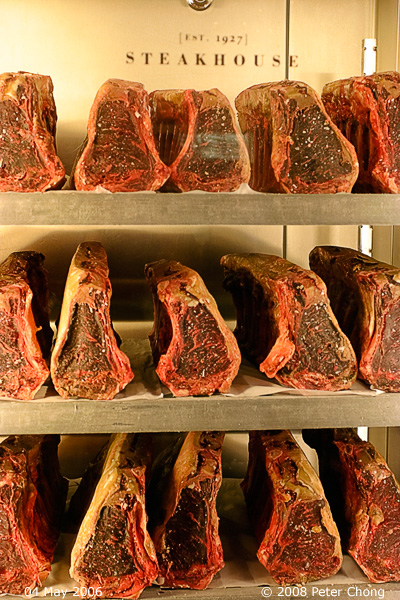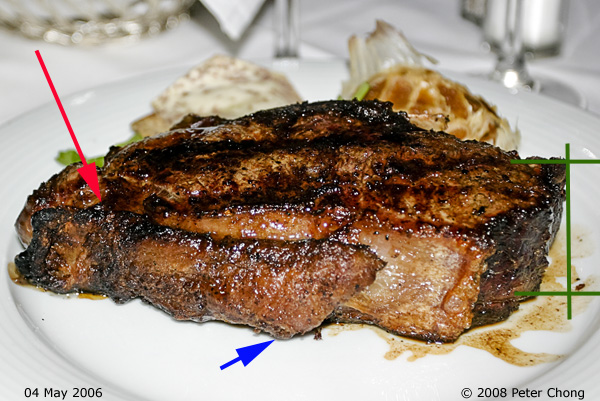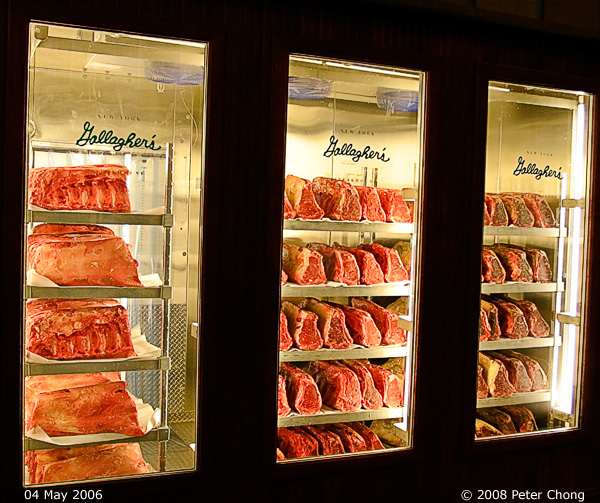My personal standard of measurement is Peter Luger in Brooklyn. They serve up a wonderful porterhouse. Closest I have eaten is the porterhouse served in Mamou's Kitchen in Fort Bonaficio, Manila. Right down to the pre-cut steak, tilted to allow the fat (butter and beef fat) to drain to one side. Thinking of it makes me salivate.
Ruths Chris are also good, especially in the US, but also their outlet in Hong Kong island in Lippo Building. A local chain in Texas called Saltgrass also serves up great stuff. Steaks in Europe are not anywhere near as good...not even the cote de boeuf in France is less wonderful than what the Americans can do. In Sydney, where they have lots of beef...they have the little restaurant downstairs of the GPO - Prime which is rather good. As is Kingsley, but they are a bit erratic...sometimes good, sometimes too dry.
I hear the Argentinians do the best steaks...or so tells me my good friend who is from Argentina...but I have not been to South America, so cannot testify to that.
So why no good steaks in Singapore? I am puzzled!
I suspect the secret is to start with, of course fantastic meat. Prime USDA Angus beef is the choice for a great steak. Typically wagyu has too much marbling to be able to provide the texture and the oomph for a great steak. Don't get me wrong, wagyu is fantastic, but my preferred method of serving the gorgeous Japanese beef is sliced, tepanyaki style, even with rice. But a char grilled steak is a manly meal...served with no sauce, no jus (I hate jus...in Australia, where they seem to love their jus, I always ask the chef to serve the jus on the side...pretending to watching my weight...they never understand if I tell them I don't want jus.)
The steak, either porterhouse or sirloin, is sliced to be about 1.5 inch thick, and thinner and you will loose too much moisture during cooking, and the steak becomes dry. (A thin steak can still taste good...like a Roman thinly sliced T-bone cooked on a pan with oil, instead of just plainly grilled comes to mind). Too thick it looses its punch.
Only air dried beef have the intensity of flavour and tenderness to make a great steak. A cut of meat is air dried in a cool environment. Dry aging is important as opposed to wet aging. Wet aging is to age the beef in a bag. 90% of beef is aged this way. The beef is vacuum packed and sealed, and left to age for a few days. The aging process will tenderise the beef, but will not impart any additional flavours.
Dry aging is as its name suggests...the meat is aged in air, and this is not preferred by butchers and steakhouses as the process will cause a shrinkage of up to 20% of the meat by weight. The cuts (note the beef is not cut into steak sized cuts, but whole chunks) are air dried from 7 to 20 days, during which a complex chemical reaction by the enzymes within the meat takes place to tenderise the meat, and concentrates the flavours. At the end of the aging process, a thick crust develops on the meat...like jerky.
Why 7 to 20 days? From day 7 onwards, or as the chef/butcher determines as the desired aging period, two slices of steak sized cuts can be removed from each end of the meat, and the rest goes into the chiller for further air drying. Slices are taken out at intervals determined by the chef/butcher. The end cuts are then trimmed off the jerky, and grilled. This is quite an involved process, plus the loss of mass of the meat makes air drying not popular with steakhouses except those who insist on highest quality.

Note the heavy marbling and the jerky like crust on the meat. The fat in the marbling will gently cook the meat, and will impart a wonderful flavour. And will provide the necessary tenderness to the beef.
A steak should be grilled over a hot charcoal fire, and no other seasoning except for salt and pepper added after it is cooked. I like mine done Chicago style medium. This style of doneness means the beef is cooked until the outsides are sealed, and the inside is cooked (typically about 55C core temperature), but still pink and moist. Chicago style means the meat is then charred on the outside. Beautiful.

Here is a cut of sirloin, grilled to perfection - Chicago medium. Note the red arrow showing the charred sides. The blue arrow points to the fat characteristic to a cut of sirloin. Note also the steak is at least 1 inch thick after cooking as shown by the green markings. Some steakhouses will allow you to trim off the layer of sirloin fat at your table after it is served to you, and toast it to a crispy crackling.

Pictures taken at Gallagher's Steakhouse in Las Vegas. Gallagher's is a famous steakhouse founded in New York City in 1927, and the NYC outlet is a 1 star Michelin.
6 comments:
Yep! Haven't had a great steak for a long long time! We are still looking for someone who would age the beef for us!
wanna try dry aging ourselves? I have some recipe-like instructions.
Mag's Wine Kitchen at circular road actually serves aged beef
thanks anonymous...but is Mag's air dried or wet dried?
Wow...I never thought that having a good steak involve so many processes, I always thought that a good steak should be as fresh as possible, meaning by cutting of a live cow even better. hmm... I still have a lot to learn. Sincerely Thanks your sharing!
That's a wonderful review. Have u tried Le Bouchon at Ann Siang? Actually, I went to Bedrock recently, next to Oriole. Their steaks are quite good, had mine rare to medium rare, which is how I like it.
Post a Comment